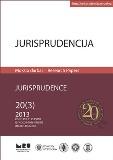Kibernetinių technologijų panaudojimo ginkluotuose konfliktuose poveikis tarptautinei humanitarinei teisei
The Influence of Using Cyber Technologies in Armed Conflicts on International Humanitarian Law
Author(s): Justinas ŽilinskasSubject(s): Law, Constitution, Jurisprudence
Published by: Mykolas Romeris University
Keywords: armed conflict; cyber conflict; international humanitarian law; cyber weapon
Summary/Abstract: Cyber warfare is becoming a new reality with new battles fought everyday on virtual battlefields. For a century and a half, International Humanitarian Law has been a sentry for victims of wars guaranteeing their legal protection from the calamities of war, trying hard to respond to Clausewitz’s “chameleon of war”. Cyber conflict marks new chameleon’s colour together with the unmanned aerial vehicles, autonomic battle systems and other technologies deployed on battlefields. However, it would be greatly erroneous to claim that the International Humanitarian Law may not apply to the new phenomena just because it is caused by the advanced technology. Even if the Geneva Conventions of 1949 are already sixty years old, the International Humanitarian Law in itself has at minimum customary response mechanism, granting, in a spirit of Marten’s clause, protection and authority of the principles of international law derived from established custom, from the principles of humanity and from dictates of public conscience (Protocol I). Notwithstanding, some more complicated fundamental issues also have to be addressed: how the use of cybernetic weapons and means may affect the classic notion of armed conflict? How it can be interpreted in the light of new technologies, i.e. can we still rely on a classic understanding of weapon’s kinetic effect as the main element, or shall we embrace effectsbased “Schmitt’s criteria”. If it so happens, will it make an act without apparent damage to a person/property equal to military hostilities, required by the armed conflict notion and justify the real-life response to it. The effective or overall control tests were used for the attribution of non-state actor’s activity to the state party of an armed conflict but these tests might not meet its purpose in the virtual battlefield of loose networks and open-source communities. If the concept of armed conflict is treated more flexibly, other changes (including issues of attribution) may follow, as well. Perhaps this is the way how the combatant institute will evolve. With classic combatant’s criteria impossible to apply on virtual battlefields, one of the options would be to elaborate concepts of “constant combat function” and “direct participation in hostilities” more precisely, as well as to reconsider state’s affiliation requirements.
Journal: Jurisprudencija
- Issue Year: 20/2013
- Issue No: 3
- Page Range: 1195-1212
- Page Count: 18
- Language: Lithuanian

